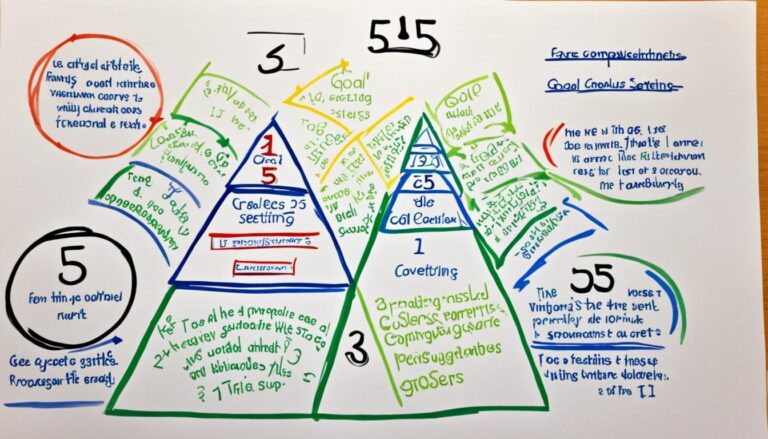Unlock Success with Goal Setting Theory Today

Do you ever feel like you’re spinning your wheels, working hard but not getting anywhere? Are you tired of setting vague goals that never seem to materialize? What if there was a proven method that could help you achieve remarkable results in your personal and professional life?
Introducing goal setting theory – a powerful concept developed by Edwin A. Locke that connects goal setting and task performance. By understanding and implementing goal achievement strategies and setting SMART (Specific, Measurable, Attainable, Relevant, and Time-bound) goals, you can unlock your full potential and turn your aspirations into achievements.
Key Takeaways:
- Goal setting theory connects goal setting and task performance, empowering individuals to achieve remarkable results.
- Setting clear, specific, and challenging goals is key to unlocking success.
- Implementing goal achievement strategies and setting SMART goals improves motivation and performance.
- Goal-setting theory can be applied in various situations, such as the workplace and project collaboration.
- While goal-setting theory offers benefits like increased engagement and job satisfaction, limitations should be considered.
What is Goal-Setting Theory?
Goal-setting theory, also known as the goal-setting theory of motivation, was developed by Edwin A. Locke. This organizational psychology theory suggests that goals that are clear, specific, and challenging are more motivating than vague or easy goals. According to the theory, when individuals are more motivated, they are more likely to succeed in achieving their goals.
Goal-setting theory serves as the foundation for the popular goal setting framework known as SMART goals, which stands for Specific, Measurable, Attainable, Relevant, and Time-bound goals. By understanding and applying goal-setting theory, individuals can enhance their motivation, focus, and performance.

Understanding Goal-Setting Theory of Motivation
Goal-setting theory, developed by Edwin A. Locke, is a motivational framework that emphasizes the importance of setting clear, specific, and challenging goals. When individuals have objectives that are well-defined and demanding, they tend to be more motivated to succeed. By understanding goal-setting theory, you can harness its power to drive your personal and professional growth.
- Clear goals: Goal-setting theory emphasizes the need for goals that are unambiguous and easy to understand. A clear goal provides direction and focus, helping you stay on track toward achieving your desired outcome.
- Specific goals: Specificity is crucial when setting goals. By clearly defining what you want to achieve, you can create a roadmap that guides your actions. Specific goals offer clarity and help you avoid ambiguity.
- Challenging goals: According to goal-setting theory, goals that challenge and stretch your capabilities can boost motivation. When you set challenging goals, you push yourself to go beyond your comfort zone, fostering personal growth and achievement.
The Role of Goal-Setting Theory in Motivation
Goal-setting theory plays a fundamental role in motivation. By understanding the underlying principles of this theory, you can leverage it to increase your motivation and drive better performance.
When you set clear, specific, and challenging goals, you provide yourself with a target to work towards. This target acts as a source of motivation, fueling your determination to succeed. The goal-setting theory of motivation suggests that individuals who are more motivated are more likely to exert effort and persist in their endeavors.
Setting SMART Goals
To effectively apply goal-setting theory, it is essential to set SMART goals. SMART goals are Specific, Measurable, Attainable, Relevant, and Time-bound. By following this framework, you can align your goals with the core principles of goal-setting theory, maximizing your motivation and chances of success.
| SMART Goals | Description |
|---|---|
| Specific | Clearly define what you want to achieve |
| Measurable | Establish metrics or criteria to track progress and determine success |
| Attainable | Set goals that are challenging yet realistically achievable |
| Relevant | Ensure your goals align with your overall objectives and values |
| Time-bound | Set a specific timeframe for achieving your goals |
How Goal-Setting Theory Works
Goal-setting theory is a powerful framework that drives motivation and improves task performance. This theory operates on the principle that goals should be both challenging and specific in order to be effective. By setting clear and ambitious goals, individuals are motivated to strive for excellence and achieve remarkable results.
There are five key principles of goal-setting theory:
- Clarity: Goals must be well-defined and unambiguous. Clear goals provide a sense of direction and enable individuals to focus their efforts towards a specific outcome.
- Challenge: Goals should be challenging and require individuals to stretch beyond their comfort zones. Challenging goals ignite motivation and inspire individuals to surpass their previous accomplishments.
- Commitment: Individuals must be committed to their goals in order to achieve them. Commitment involves dedicating time, energy, and resources towards goal attainment.
- Feedback: Regular feedback on progress towards goals is crucial. Feedback helps individuals monitor their performance, make necessary adjustments, and stay on track towards goal achievement.
- Task Complexity: Goals should be matched to the complexity of the task at hand. Different tasks require different levels of goal difficulty to optimize performance.
Understanding these principles is essential for leveraging the power of goal-setting theory and enhancing task performance. By applying these principles, individuals can set challenging goals, stay committed, receive feedback, and make adjustments to optimize their performance.

| Principle | Description |
|---|---|
| Clarity | Goals must be well-defined and unambiguous. |
| Challenge | Goals should be challenging and require individuals to stretch beyond their comfort zones. |
| Commitment | Individuals must be committed to their goals in order to achieve them. |
| Feedback | Regular feedback on progress towards goals is crucial. |
| Task Complexity | Goals should be matched to the complexity of the task at hand. |
Examples of Goal-Setting Theory in Practice
Goal-setting theory is not just a theoretical concept. It has practical applications in various settings, including the workplace. Let’s explore some real-life examples of how goal-setting theory can be applied effectively.
Successful Onboarding
When it comes to welcoming new employees into an organization, goal setting plays a crucial role in ensuring their successful onboarding. By setting clear and challenging goals for new hires, such as learning specific skills or completing tasks within a certain timeframe, organizations can motivate and engage their employees right from the start.
For example, imagine a software development company that hires a new programmer. As part of their onboarding process, the company sets goals for the new employee to learn the programming language, familiarize themselves with the company’s coding standards, and complete a small coding project independently within the first month. These goals not only guide the employee’s learning and development but also establish expectations and boost their motivation to succeed.
Finishing a Project with a Team
Goal setting can also be instrumental in driving team collaboration and the successful completion of projects. By setting a clear goal and breaking it down into smaller tasks for each team member, organizations can foster a sense of shared purpose and motivate individuals to work together towards a common objective.
For example, let’s consider a marketing agency working on a campaign for a new product launch. The project manager sets a goal for the team to create and implement a comprehensive marketing plan within a specified timeline. They then assign specific tasks to each team member, such as conducting market research, designing promotional materials, and executing digital advertising campaigns. With clear goals and individual responsibilities, the team members are motivated to collaborate, share ideas, and support each other to achieve the desired outcome.
An Inspirational Example
One inspiring example of goal-setting theory in action is Elon Musk’s ambitious goal of making humanity a multi-planetary species through SpaceX’s efforts. Musk and his team set clear and challenging goals to develop reusable rockets, establish colonies on Mars, and create a viable interplanetary transportation system.

Through their commitment to these goals, SpaceX has accomplished remarkable milestones, such as achieving reusable rocket landings and launching missions to the International Space Station. This example not only demonstrates the power of goal setting but also highlights how it can drive innovation, scientific exploration, and ambitious endeavors that benefit humanity as a whole.
| Example | Setting | Outcome |
|---|---|---|
| Successful Onboarding | New employees | Motivated and engaged employees from the start, faster integration into the organization |
| Finishing a Project with a Team | Project teams | Improved collaboration, enhanced productivity, successful project completion |
| An Inspirational Example | SpaceX | Achievement of groundbreaking milestones and progress towards interplanetary colonization |
Benefits and Limitations of Goal-Setting Theory
Goal-setting theory offers several benefits when used effectively. It can lead to higher levels of engagement, performance, and job satisfaction among employees. By setting clear and challenging goals, individuals are motivated to push beyond their limits and achieve remarkable results. When goals are specific and measurable, individuals have a clear roadmap to guide their actions and measure their progress along the way. This promotes a sense of focus and direction, allowing individuals to prioritize tasks and make efficient use of their time and resources.
Another benefit of goal-setting theory is its ability to create a culture of feedback and accountability. When goals are set, individuals can regularly assess their performance, receive constructive feedback, and make necessary adjustments to stay on track. This feedback loop fosters continuous improvement and cultivates a growth mindset, encouraging individuals to constantly strive for excellence.
Additionally, goal-setting theory plays a crucial role in fostering self-efficacy. When individuals set and achieve goals, they develop a sense of competence and self-confidence in their abilities. This, in turn, empowers them to tackle even more challenging goals and overcome obstacles with resilience and determination.
Limitations of Goal-Setting Theory
While goal-setting theory offers numerous benefits, it is important to consider its limitations. One limitation is the potential negative impact on performance when goals are set that are too difficult or complex for individuals to achieve. If goals are perceived as unattainable, it can lead to frustration, demotivation, and a decline in performance.
Misalignment between individual and organizational goals can also hinder the effectiveness of goal-setting theory. When goals are not aligned with the overall objectives of an organization, individuals may prioritize their personal goals over those of the organization, resulting in a lack of cohesion and synergy within teams.
Lastly, if goals are not set ethically or are overly focused on a single aspect of performance, such as productivity or profitability, it can lead to risky or unethical behavior. In pursuit of meeting their goals, individuals may resort to unethical practices or take unnecessary risks that can harm the organization and its stakeholders.
By understanding both the benefits and limitations of goal-setting theory, individuals can optimize their use of this framework and effectively leverage its power to drive performance and achieve success.

Conclusion
In conclusion, goal setting theory is a powerful tool that can unlock success and empower individuals to achieve their goals. By understanding the principles and application of goal-setting theory, you can set clear, specific, and challenging goals that inspire motivation and drive performance.
While there are limitations to consider, the benefits of goal-setting theory, such as increased engagement, productivity, and job satisfaction, make it a valuable strategy for personal and professional growth.
By embracing goal-setting theory and implementing goal achievement strategies, you can transform your aspirations into achievements and reach new heights of success. So, set your goals with intention, follow the SMART criteria, and watch your dreams become reality. Goal setting is the first step on your journey to success!






